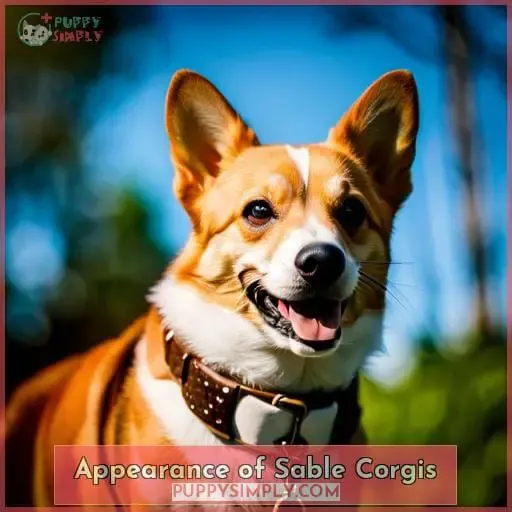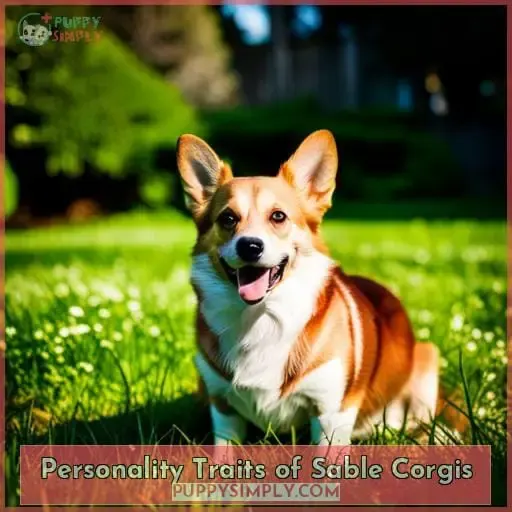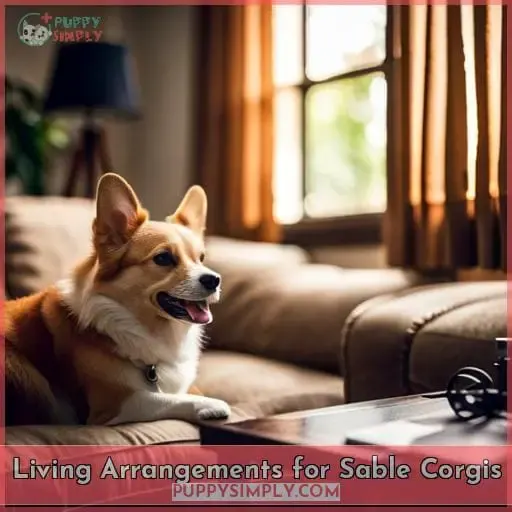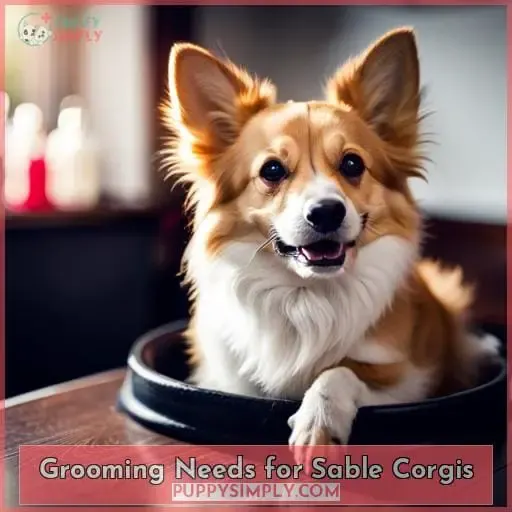This site is supported by our readers. We may earn a commission, at no cost to you, if you purchase through links.
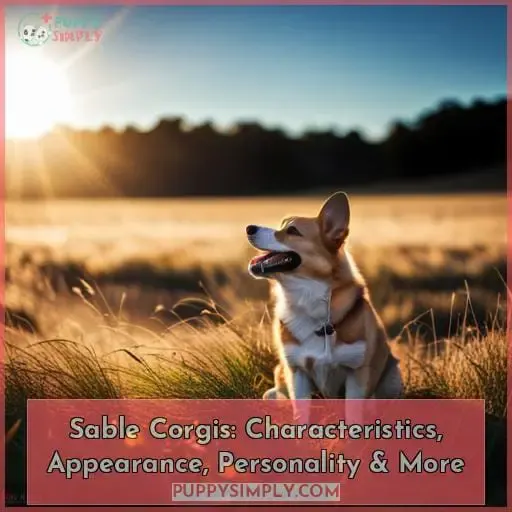 Are you looking to add a new furry friend to your family? Look no further than the Sable Corgi! This unique breed offers an interesting mix of personality, appearance, and characteristics that set it apart from other breeds.
Are you looking to add a new furry friend to your family? Look no further than the Sable Corgi! This unique breed offers an interesting mix of personality, appearance, and characteristics that set it apart from other breeds.
With its iconic fluffy coat and vibrant sable coloration, this dog is sure to turn heads wherever they go. But don’t be fooled by their cute looks – these dogs are also fiercely loyal companions with a spunky attitude that will keep you entertained for hours.
From training advice and living arrangements to grooming needs and barking tendencies, we’ve got all the information you need here about Sable Corgis so read on!
Table Of Contents
- Key Takeaways
- Characteristics of Sable Corgis
- Appearance of Sable Corgis
- Personality Traits of Sable Corgis
- Living Arrangements for Sable Corgis
- Grooming Needs for Sable Corgis
- Barking Tendencies in Sable Corgis
- Weight Management for Sable Corgis
- Pricing and Cost of Sable Corgis
- Training Considerations for Sable Corgis
- Conclusion
Key Takeaways
- Sable Corgis have a distinctive appearance with a black cast on the back, shoulders, and tailhead, and a white underbelly.
- They were originally used as herding dogs in Wales and gained popularity during Queen Elizabeth II’s reign.
- Sable Corgis are spunky and fiercely loyal companions but may have excessive barking tendencies if not properly trained.
- They require regular exercise, grooming, and socialization, and the price can vary depending on the specific variety of Corgi.
Characteristics of Sable Corgis
You’ll love the distinctive look of a sable Corgi, with its black cast on the back and shoulders, red main coloring, and white belly – all adding to their intelligence, loyalty, and sociability! Sable Corgis have a unique temperament that makes them an ideal pet for active families.
When it comes to coat color patterns in sables, there are many variations depending on which parent breed they come from. Pembroke or Cardigan Welsh corgis will often show different shades due to mixed genetics.
It’s important for owners of sable corgis to be aware of potential health issues such as obesity caused by a lack of exercise. Regular daily walks or playful activities should be provided regardless of whether you live in apartments or homes with yards.
Sables have been around since antiquity when they were used as herding dogs by farmers in Wales centuries ago. They only recently gained popularity after Queen Elizabeth II popularized them during her reign over Britain starting in 1952.
She has amassed around 30 individual pets across several generations. In addition, these pups impressively display their bravery despite being small-sized, making them excellent guard dogs. However, this trait can also lead to excessive barking habits that require proper training methods like firmness combined with socialization techniques using positive rewards systems throughout life stages.
One final point about living conditions: while some households may work better than others, it is highly recommended to have enough space both indoors and outdoors considering how much energy these pooches possess.
Plus, frequent grooming needs, especially if shedding season arrives twice per year. All together, these features make up why owning one would bring joy, companionship, laughter, and entertainment moments among friends and family members alike, no matter what background experience level you’re coming from.
Sable Corgis truly embody why people everywhere fall madly, deeply, and forever passionate about this beloved pup species worldwide.
Appearance of Sable Corgis
The appearance of sable Corgis is distinct, with a black cast on the back, shoulders, and tailhead. They often have white fur on their underbelly and may appear to be lighter or darker brown in certain areas.
For example, one Sable Corgi named Daisy had a unique mix of golden-brown hair around her ears that made her stand out from other members of the pack!
Sable Corgis come in various colors depending on their genes. They can range from red to black and white hues. The most common color variations are cinnamon merle corgis, which have both red and white fur along with dark markings.
Traditional sables consist primarily of red, accented by patches or streaks of black throughout their coat patterning.
These beautiful dogs also feature a widow’s peak. This is where you will find a V-shaped patch at the top center portion near their forehead area, featuring more intense coloring than anywhere else across its body.
It is an even deeper shade compared to what’s found elsewhere within its coat designations.
To further distinguish between Pembroke Welsh Corgi vs Cardigan Welsh varieties, look for differences in tails. Pembrokes typically possess shorter tails, while Cardigans display longer ones. Additionally, there are ear distinctions too, as Cardigans sport larger/longer ears.
All these features combined make it easy for any pet lover to identify them quickly when out walking during warmer climates, especially due to how bright and vibrant all those color combinations become once fully exposed beneath direct sunlight exposure!
Personality Traits of Sable Corgis
Discovering the delightful personality traits of sable Corgis can bring endless joy and laughter to your home. These fluffy furballs are incredibly loving, loyal companions that will bond with their owners quickly.
They have a bright energy and an eagerness to please, making them easy to train in obedience or agility exercises.
However, they may also develop some bad habits if not given proper socialization from an early age – such as nipping at heels when excited or barking excessively when bored – so it’s important for sable corgi owners to set boundaries right away.
With regular exercise needs and a range of coat variations due to their breed mix heritage, these dogs make great family pets who love interaction and affection! Sable corgis have high intelligence levels, which means they need plenty of mental stimulation throughout the day; otherwise, behavioral problems like destructive behaviors may arise due to their natural boredom tendencies.
While this breed is naturally friendly towards people, they should still be taken out for daily walks, playdates with other dogs, or trips outside where possible.
Additionally, depending on what type of sable coloration you end up getting (ranging from red-headed tri-color puppies starting black & white with red points all the way through cinnamon merle’s), there could be even more unique characteristics present within each individual pup!
When considering adopting a Sables Corgi into your life, it’s important to factor in both cost – which ranges anywhere between $400-$4000 based on health tests required – as well as patience needed during training sessions since this particular dog requires firm discipline coupled alongside a positive reinforcement rewards system for best results.
All said though, once you do manage to successfully introduce one into yours? You won’t regret it: after all, nothing beats having such an adorable little companion by our side, especially those pups sporting that beautiful signature widow’s peak V pattern atop its head either!!
Living Arrangements for Sable Corgis
With their small size and adaptable nature, sable Corgis are suitable for both apartments and homes with yards. They need regular exercise to stay healthy, but this does not require a large space as they have low energy levels.
For apartment living, daily walks or playtime in the park is sufficient for them to get all the physical activity they need while providing socialization opportunities. Even though these dogs don’t require much yard space for exercise needs, having a secure outdoor area can be beneficial so your pet can enjoy some fresh air and sunshine safely without being taken away by other animals or people.
When it comes to socialization tips for sable corgis living in an apartment setting, introducing them early on to new people helps prevent shyness later on in life.
Additionally, keeping up regularly scheduled visits from groomers who specialize in corgi coat care ensures that you maintain those beautiful recognized colors such as redsaber, fawnred, headed tri color, and black headed tri color, which make this breed so unique!
Living arrangements for Sables Corgi may vary depending on lifestyle preferences. However, no matter what housing situation you choose, plenty of love, attention, grooming time outdoors (weather permitting), along with mental and physical stimulation should always be provided if possible.
This ensures that each individual furry family member gets all he/she needs to live happy, contented lives.
Grooming Needs for Sable Corgis
You’ll need to keep up with regular brushing to maintain your Corgi’s sable coat! A sable corgi is a unique breed of Corgi with distinct markings and colors. Grooming them requires special care due to their long double coats and the variety in color patterns.
Here are some tips for grooming your sable corgi:
- Brush frequency – Brush at least twice a week to prevent mats from forming in the fur and control shedding throughout the year.
- Shedding control – During heavier periods of shedding, such as summer months or when they blow their undercoat twice per year, more frequent brushing may be necessary to avoid excess fur around your house and on furniture, clothes, etc.
- Grooming tools – Invest in good quality brushes to ensure an even groom across all areas of your pet’s body.
- Coat Care – Regularly clean any dirt or debris that accumulates on the coat to maintain its natural oils and keep the skin healthy underneath. This also helps your Corgi look great! Additionally, daily combing through knots helps prevent them from becoming full-blown mats that require cutting out by professional groomers (which should always be done carefully).
With proper care and attention given to both physical health and emotional well-being, your Sable’s beautiful double-layer coat will remain gorgeous forever!
Barking Tendencies in Sable Corgis
After considering the grooming needs for sable Corgis, let’s take a look at their barking tendencies. Being vocal is part of being a corgi, and they can bark excessively if not trained properly. The causes of excessive barking may be due to anxiety, boredom, or territorial behavior.
In addition to training techniques like positive reinforcement and reward-based methods, providing plenty of socialization opportunities for your sable Corgi will also help reduce unnecessary barking episodes.
Taking them out on walks in different areas with other animals or people, as well as exposing them to new situations, will help improve their temperament and curb any aggressive behaviors that may lead to excessive barking habits over time.
Behavior modification through clicker training can also teach your pet how to respond differently when faced with certain triggers that cause him/her distress, such as loud noises or strangers coming into the house unannounced – something you would want from all dogs, but especially one that tends towards more active behavior than others!
Finally, keep an eye on your sable Corgi’s health. Any medical issues could manifest themselves in increased levels of noise-making, so it’s important not only for his overall well-being but also his communication skills that he stays fit and healthy!
Weight Management for Sable Corgis
To keep your sable companion healthy, you must manage their weight with regular exercise and a balanced diet. Corgis are prone to becoming overweight, as they have been bred for centuries to do the same job – herding livestock – that requires lots of energy.
The Pembroke Welsh Corgi and Cardigan Welsh Corgi breed standards both recommend an ideal bodyweight range between 22-30 pounds (10-14 kg).
Here are some tips on managing your Sable’s weight:
- Exercise Regularly: Incorporate daily walks into your routine, combined with interactive play sessions such as fetch or tuggy toys at least twice a day in order to provide enough physical stimulation for them. This will not only help maintain their muscle tone but also prevent boredom, which could lead to overeating or destructive behavior.
- Monitor Nutrition Intake: Make sure you feed them high-quality dog food appropriate for their age and size according to the manufacturer’s instructions. Measure out portions carefully rather than free feeding all day long! Supplements such as omega 3 fatty acids can be beneficial in keeping skin & coat health, while avoiding excessive calories from treats or snacks throughout the day is key towards successful weight management efforts.
- Veterinary Visits: It is important that you bring him/her for regular visits to veterinary clinics so any potential health issues related to his/her excess bodyweight may be detected early on before it becomes a more serious problem down the line.
By following these simple guidelines, along with providing plenty of mental stimulation through socialization activities like obedience classes if possible, we can make sure our Sable friends remain happy & healthy companions well into old age!
Pricing and Cost of Sable Corgis
The price of owning a sable corgi can range from an affordable $400 to an extravagant $4,000 – but the joy they bring is priceless! Fortunately for those on a budget, there are still sables available at more reasonable prices.
The type of Corgi breed you choose will also affect cost; Pembroke Welsh Corgis tend to be less expensive than Cardigan Welsh Corgis. Additionally, health tests like hip and elbow scoring or eye exams may add hundreds of dollars onto the bill as breeders strive for healthier dogs.
If purchasing from a breeder isn’t in your plans, adoption fees are often lower than buying directly from one and include spay/neuter costs along with basic vaccinations. However, while these organizations provide loving homes to abandoned pets, their resources may not always have enough Sable Corgi puppies ready for adoption right away.
Whether adopting or buying directly through a breeder, just remember that even though Sable Corgis require some extra TLC due to their herding instinct (and potential barking), they make wonderful companions who excel when given plenty of love and attention – which ultimately makes them worth every penny spent on them!
Training Considerations for Sable Corgis
Training sable corgis can be a rewarding experience if you understand their herding instincts and are prepared to address any excessive barking. Managing these behaviors requires firmness, socialization, and reward-based methods in order to create an obedient companion for life.
Training sable corgis:
You’ll need to be firm but gentle when training your sable pup, as they respond best to rewards-based methods. Socialization is key for a well-behaved corgi, so introduce them early and often to new people, places, and things.
Behavior modification techniques should be used if needed; positive reinforcement works best rather than punishing bad behavior.
Sable Corgis have an eagerness to please their owners, which makes learning these behaviors much easier than other breeds of dogs that may not pay attention as easily or quickly understand instructions.
With dedication from both you and your furry pal, teaching them proper manners will set up both of you on the path towards a lifetime of companionship full of lots of love and laughter!
Managing herding instincts:
Be mindful of your sable Corgi’s herding instinct as it can lead them to nip or attempt to herd people.
- Establish yourself as the pack leader by providing consistent rules and boundaries.
- Teach basic commands, such as sit, stay, come, and leave it. Use positive reinforcement methods such as praise and treats when training.
- Provide socialization opportunities with other dogs from an early age so they know how to behave around other animals properly.
- Exercise their minds through activities like agility or obedience classes; provide plenty of physical exercise too! This breed needs lots of activity to stay healthy mentally and physically.
With proper management techniques, you can ensure a happy home life with your Sable Corgi companion! They have independent personalities but respond well to clear direction while being affectionate family pets at the same time – a great combination indeed!
Addressing excessive barking
Help your sable pup become the best companion with training to address excessive barking. Use positive reinforcement, such as rewarding desired behavior with treats or praise. Socialization techniques also help reduce noise control issues by teaching appropriate ways to interact with people and other animals.
Identify behavioral triggers that lead to barking and work on those specific situations for better results. Teach formal recognition of commands through repetition and consistency. Show patience during each lesson to encourage good habits in your pet corgi and reinforce positive behaviors over time.
Conclusion
Sable Corgis are an adorable and affectionate breed that bring a lot of joy and companionship to their owners. They have a unique coat color and markings that are sure to turn heads wherever they go. With their herding instinct, sable Corgis may require training to manage their behavior, but they are eager to please and easy to train.
Regular brushing and weight management are also essential for sable Corgis to ensure they stay healthy and happy.
The price of a sable Corgi can range from $400 to $4000, depending on health tests and the breeder. Regardless of the cost, sable Corgis are an excellent addition to any household. They provide their owners with companionship, laughter, and a loyal companion for life.


